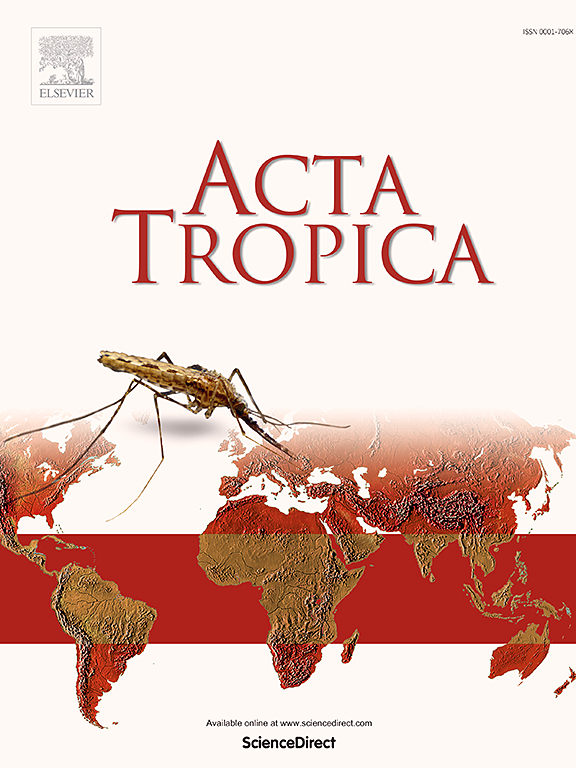Morpho-molecular characterization of tick species prevalent in domesticated and semi-domesticated bovine species in three districts of Arunachal Pradesh
IF 2.1
3区 医学
Q2 PARASITOLOGY
引用次数: 0
Abstract
Ticks are small, blood-sucking arthropods that pose a significant threat to public health and animal welfare worldwide. However, information on the relationships between tick species diversity, altitudinal gradients and hosts in Arunachal Pradesh is limited. This study investigates tick prevalence across five locations in Arunachal Pradesh, India, at altitudes ranging from 140 m to 1200 m. Scanning electron microscopy (SEM) and sequencing of the mitochondrial 16S ribosomal RNA gene (rRNA) and nuclear second internal transcribed spacer (ITS2) were used for morpho-molecular identification of tick species. Morphological and molecular phylogenetic analyses confirmed the presence of tick species: Rhipicephalus microplus, Amblyomma integrum, Haemaphysalis longicornis, Haemaphysalis bispinosa and Ixodes ovatus. This study provides the first report on the ITS2 gene sequence and phylogenetic analysis of A. integrum. Among the tick species, R. microplus emerged as the most dominant tick species across all altitudes and seasons in the study areas. Host-specific observations showed that Bos frontalis hosted a larger variety of ticks compared to Bos indicus in most locations. This study describes the use of SEM and 16S rRNA/ITS2-based molecular analysis for tick species identification and highlights the seasonal predominance and species richness of ticks across different altitudes and hosts.

**三区家养和半家养牛中常见蜱类形态分子特征分析。
蜱是一种小型的吸血节肢动物,对全世界的公共卫生和动物福利构成重大威胁。然而,关于**地区蜱类多样性、海拔梯度和寄主之间关系的研究资料有限。采用扫描电镜(SEM)和线粒体16S核糖体RNA基因(rRNA)及核第二内转录间隔段(ITS2)测序技术对蜱种进行形态分子鉴定。形态学和分子系统发育分析证实存在微头蜱、整体无足蜱、长角血蜱、双皮血蜱和卵硬蜱。本研究首次报道了拟南芥ITS2基因序列及其系统发育分析。在蜱类种类中,在研究区各海拔、各季节均以微小蜱为优势种。寄主特异性观察表明,在大多数地点,与印度寄主相比,frontalis寄主的蜱种类更多。利用扫描电镜和基于16S rRNA/ its2的分子分析方法对蜱类进行了鉴定,揭示了蜱类在不同海拔、不同寄主的季节优势和物种丰富度。
本文章由计算机程序翻译,如有差异,请以英文原文为准。
求助全文
约1分钟内获得全文
求助全文
来源期刊

Acta tropica
医学-寄生虫学
CiteScore
5.40
自引率
11.10%
发文量
383
审稿时长
37 days
期刊介绍:
Acta Tropica, is an international journal on infectious diseases that covers public health sciences and biomedical research with particular emphasis on topics relevant to human and animal health in the tropics and the subtropics.
 求助内容:
求助内容: 应助结果提醒方式:
应助结果提醒方式:


